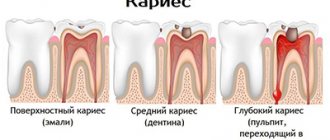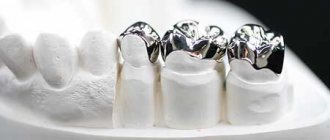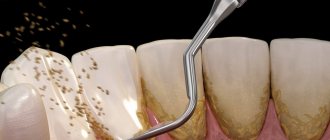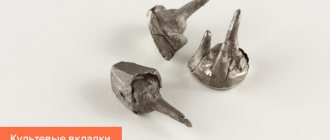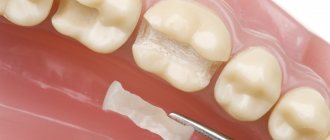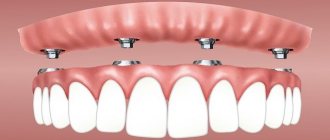In modern dentistry, there are many different methods for restoring damaged teeth - filling, prosthetics, installing inlays. The first two technologies are well known to patients, but few people know that teeth can be successfully restored with inlays.
What are tooth inlays, how do they differ from regular fillings, and in what cases is the use of inlays indicated? We will answer all these questions in detail in this article on our website.
What is it - a tooth tab?
Dental inlays are microprostheses that can be used for different purposes. Restorative or restorative inlays are used like fillings: they help recreate the natural crown of a tooth, keeping it alive. Stump inlays are used in cases where it is necessary to restore a badly damaged tooth under a crown. Let's take a quick look at why restoration and stump inlays are used, and find out the difference between them.
Restoring inlays are stronger than conventional dental fillings and differ from them in the technology of their creation: dental inlays are not made directly in the patient’s mouth, like fillings, but in a dental laboratory, using previously taken impressions. Because microdentures are made in a laboratory setting, they are also called indirect dental inlays.
The inlays exactly repeat the shape of the cavity that needs to be closed for tooth restoration and fit tightly to the natural tissues. The high density of adhesion of the inlay to the tooth tissue eliminates the risk of developing caries in the gap between the installed microprosthesis and the tooth. Restoring a tooth with an inlay will help keep the tooth alive in a situation where a sufficient amount of tooth tissue has been preserved, its nerve is alive and well, but a large filling still needs to be placed. Large fillings do not stick well to the teeth and can break under stress, along with the tooth. Inlays have a long useful life, can withstand chewing loads well, and their use makes it possible not to rush into dental prosthetics with a crown, which often requires preliminary depulpation of teeth.
Stump inlays for a tooth are no longer a restoration element, but a technical one. It acts as a support for the installation of a dental crown in cases where the tooth cannot be restored qualitatively with a conventional filling. In order not to confuse stump and restoration inlays, the easiest way to classify them is as follows: restorative inlays are installed outside the living tooth, stump inlays are always located under the crown.
This is the main classification of inlays, but they can also differ in the type of material they are made of, and below we will definitely talk about all the types of microprostheses and their features. But first, let's find out who and when is recommended to install inlays on teeth.
Installation procedure
The inlay is installed into the tooth in several stages.
- First, the condition of the teeth is checked and an impression is made. Creating a finished tooth takes up to two weeks. At this time, a temporary tab is placed.
- Then the newly made inlay is adjusted to the size of the damaged tooth. It should fit completely onto the affected tooth. Then its perfect fit is checked. The doctor administers an anesthetic to the patient, and the tooth is fixed. The inlay is attached to the tooth with dental cement or glue, then it is ground down.
If the patient carefully monitors the condition of his teeth and regularly cleans his mouth of food debris, the inlay’s validity period reaches 10 years.
Indications for dental restoration with inlays
Let's look at all the cases in which the use of tabs may be indicated. It is recommended to use tabs:
- If the tooth is destroyed by more than 1/3;
- With increased wear of chewing teeth;
- When restoring teeth that in the future will have to act as a support for a crown or installation of a bridge;
- For large carious cavities in the teeth, the elimination of which with conventional fillings is ineffective.
The need to use inlays is determined by the dentist during the examination of the patient. Based on the clinical situation, the specialist will choose the type of microprosthesis that is suitable for you, both in terms of functionality and material of manufacture.
Differences
- The pin puts pressure on the root of the tooth, which can cause it to become loose; there is pressure on adjacent teeth, and the inlay eliminates this load.
- Time of use - the pin can be used for up to 3 years, the inlay - much longer, almost 10 years.
- The pin is a single design, but the tab can separate.
- It is not difficult to make a pin, but to make an inlay, laboratory specialists are involved and special studies are carried out.
- The installation of the pin is carried out in one visit to the dentist; to install the inlay, you will have to visit the doctor at least twice.
- If the tooth has a crooked root, you can only use an inlay.
- The cost of an inlay is significantly higher than a pin.
- Preparing the tooth for the installation of a pin is relatively gentle; in order to install the inlay, a large amount of tissue is removed.
Types of restoration dental inlays: description, characteristics
In this section of the article, we will tell you about what restoration dental inlays can be, used in tooth restoration as an alternative to conventional fillings. Prostheses will be classified mainly according to the material of manufacture and according to this criterion, the inlays can be ceramic, composite, or metal. The material of the tooth inlay will affect both the performance characteristics of microprostheses and their cost.
Ceramic tooth inlay and its features
Most often, ceramic dental inlays are used to restore chips on living teeth and act as a high-quality and more reliable alternative to conventional fillings.
Ceramic inlays can only be placed on teeth that are alive, not loose, and have been treated for caries. Ceramic dental inlays have many advantages: they are aesthetically pleasing, durable, do not change their beautiful color even with prolonged use, and do not wear off. The high density of the marginal contact of the ceramic inlay with the natural tissues of the tooth eliminates the risk of developing secondary caries.
But ceramic dental inlays have some disadvantages. Some consider the disadvantages of ceramic inlays for teeth to be the high price of this type of microprosthesis in Moscow (from 8 thousand rubles), however, it should be noted that the high cost is fully justified by the long service life of ceramic inlays and their impeccable aesthetics. Please note that with ceramic inlays installed on your teeth, you will need to give up the habit of chewing nuts, crackers, and other types of too hard foods with your teeth. The ceramic inlay may not withstand such heavy loads!
Metal tooth tab: characteristics, pros, cons
Metal restoration inlays are used quite rarely these days, and all because microprostheses made from this material have a number of disadvantages:
- When installing metal inlays in the mouth, a very unpleasant galvanic side effect for the patient may occur, expressed in constant and profuse salivation, a pronounced metallic taste in the mouth;
- Installing metal inlays does not allow for high-quality and tight contact between the microprosthesis and the natural tissues of the tooth, and this increases the risk of developing secondary caries. Gold inlays on teeth can provide a good fit, but their price will be high, because gold is a noble and expensive metal;
- Metal inserts can cause allergic reactions;
- The aesthetics of metal inlays also leaves much to be desired.
The only significant advantage of metal inlays for teeth is the fairly low price for this type of microprosthesis in Moscow. The cost of a metal tab in the capital’s clinics starts at 4,000 rubles for one orthopedic product.
Composite inlays for teeth
Composite inlays are used to restore single-rooted teeth, which include incisors and canines, that is, the front teeth included in the smile area.
Installation of a composite inlay can only be carried out if the tissue in the tooth being restored is preserved in a volume of at least 50%. Composite inlays are also called pin inlays because when they are placed in the tooth canal, a pin is first placed on which the dentist will apply the composite material in layers. If the tooth is severely damaged, installing an inlay on a pin is not recommended, since over time the pin may begin to wobble in the tooth canal and its mobility can lead to a fracture of the tooth root. If your tooth is more than half destroyed, you do not need a restoration, but a stump inlay followed by installation of a crown!
How much will a composite tooth inlay cost? The answer to this question will depend on what type of post and composite material the dentist uses during the restoration process.
The price of a restoration insert will also depend on the method of its manufacture. All inlays, except composite ones, are created in the laboratory using dental impressions. The tooth for the inlay must be ground down, although the volume of tissue removed will be less than the amount of dental tissue that is removed for the crown. The most complex manufacturing technology is for ceramic crowns, which are made from pressed ceramics: they are created using CAD/CAM computer technology. The complexity of the technology increases the price of ceramic inlays, but such microprostheses will have high anatomical accuracy, which means they will last longer.
When is the best time to choose a ceramic inlay?
Everyone is familiar with the method of restoring the crown of a tooth by filling it with a composite material. In this case, it fills the entire cleaned carious cavity of the tooth layer by layer. However, with a large volume of damage, when the size of the cavity becomes significant, the doctor does not undertake such a procedure. Given these clinical conditions, there is a risk that, due to even slight shrinkage of the material, it is difficult to prevent chipping of the tooth wall.
If it is necessary to restore large areas of a tooth, experts consider using a ceramic inlay instead of a filling as the best solution. This will provide not only a long-lasting result, allowing you to significantly extend the life of the tooth, but also fully guarantees its aesthetic impeccability.
How are restoration inlays installed on teeth?
Installing a restorative inlay on teeth is a multi-step process that always begins with a detailed diagnosis, which will include examination, radiography and computed tomography. After the diagnosis, the type of inlay is selected and a detailed treatment plan is drawn up.
The tooth on which the inlay is planned to be placed is ground down and then an impression is taken from it and sent to a dental laboratory. An inlay will be made based on the impression and the average production time is 5-7 days.
When the inlay is ready, the patient is invited to the clinic for fitting and installation of a microprosthesis. The inlay is fixed in the tooth cavity using special dental cement.
Comparison of ceramics with other materials
Ceramics is far from the only material from which inlays are made.
They can be made from various metal alloys (including precious ones) or from a combination of metal and ceramics, but only ceramic or zirconium inlays are considered the best in terms of aesthetics and reliability. For example, a metal-ceramic tooth inlay is inferior to solid ceramics in reliability, and most metal alloys are not bioinert. The exception is gold tabs. Gold does not cause allergies, and thanks to the plasticity of the material, it is possible to “fit” the insert well and eliminate the occurrence of micro-gaps. There are nuances regarding the ceramics itself. Just 30-40 years ago, the dental industry did not have the production technology to produce reliable all-ceramic inlays. Despite the fact that ceramics is a safe and aesthetic material, it is quite fragile and poorly suited for chewing teeth, and it is the lateral teeth that are most often restored with the help of inlays. That is why special high-strength ceramics made by injection molding under high pressure are used to produce inlays. Another method is the CAD/CAM technique. This is a fully automated process. The doctor uses equipment and software that allows the patient’s individual data to be loaded into a special milling module, which cuts products from zirconium dioxide blocks. The most well-known technologies at the moment are CEREC and e.max: such inlays are considered the most reliable and aesthetic and are used in the best clinics around the world.
Is it possible to put an inlay on the front teeth?
Inlays are not used for the restoration of anterior teeth. If there is a sufficient amount of healthy tooth tissue, the tooth is restored with a regular filling and then a veneer or lumineer can be placed on it to obtain a beautiful aesthetic restoration in the smile area. If the tooth is severely damaged, then it makes sense to install a stump tab and then a crown.
The traditional area of application for restoration inlays is chewing teeth.
Can a tooth get sick under an inlay and what to do if this happens?
If the tooth under the inlay hurts, you need to urgently contact a dental clinic, because pain under the installed microprosthesis can indicate the development of various kinds of complications. The main cause of complications after installing an inlay is medical errors that were made during the treatment process, and that is why it is so important to choose dentistry carefully! If, when treating a tooth, the doctor allows the pulp to overheat, an inflammatory process may begin, as a result of which the tooth under the tab will become sore. To eliminate pulpitis, you will have to remove the tooth inlay, receive appropriate treatment, and then restore the tooth again, possibly with a prosthetic crown or even implantation.
Inlays are often placed on teeth after caries treatment and it is extremely important that when working with a carious cavity, the dentist removes all destroyed tissue. If this is not done, secondary caries will begin under the tab, the treatment of which will again require removal of the tab.
Remember that if 5-7 days have passed after installing the inlay on the tooth, and your tooth hurts and the intensity of the pain is increasing, you need to urgently see a dentist, and not try to solve the problem yourself! If the infection gets into the root part of the tooth, it is not always possible to save the tooth and avoid its removal!
If the tooth does not hurt, but you have the feeling that it is bothering you - when eating, talking, trying to close your teeth - contact the clinic where you received the inlay to have its size corrected.
Indications and contraindications
The main reason for installing an inlay is significant destruction of a normal tooth by caries. In this case, more than half of the hard tooth tissue is lost. In essence, an inlay is an extra-large (on the scale of a tooth) filling that solves a problem that in this case cannot usually be corrected with a filling.
Other indications may be: wedge-shaped damage, trauma, large and frequent chips that damage the tooth, thinning of the enamel, loss of dental tissue, installation of crowns, bridge prosthetics. One of the “painless” reasons is that the patient has noticed accelerated wear of the enamel, but the tooth does not yet hurt.
The reasons why it is better to refuse the installation of an inlay are minor caries, piecewise linear tooth relief that goes deep into the dentin (where the enamel can be weakened in advance), rapidly growing caries, insufficiently regular and frequent cleansing of the mouth from food debris, grinding teeth in sleep .
Stump inlays: what do you need to know about them?
At the very beginning of our article, we said that stump inlays should not be confused with restorative microprostheses - they are used to restore pulpless and severely damaged teeth, in which they will serve as the basis for installing a crown or dental bridge.
Stump inlays are structures consisting of two parts: a pin installed in the root canal and a support on which the crown will be fixed. Stump inlays can be monolithic or collapsible, and most often this type of structure is used when the tooth has less than 50% of healthy tissue left.
Many people are interested in the question: why is it best to use core inlays rather than fillings on a pin to restore severely damaged teeth? The fact is that the pin may not withstand the load and begin to wobble in the canal, and this will either lead to the filling breaking or falling out, or, worst of all, to damage to the tooth root, in which the tooth is most often removed. Stump inlays allow you to avoid such risks because they distribute the load more correctly and themselves have much greater strength compared to pins.
Stump inlays are also made in the laboratory and the construction material is selected to match the type of dental crown that is planned to be placed in the future. Metal core inlays are used for metal-ceramic crowns, and zirconium inlays are used for ceramic crowns. If you make a metal inlay for a ceramic crown, it can shine through the thin and transparent material of the crown, which will have a bad effect on the aesthetics of the restoration.
Tooth restoration using a core inlay will also be divided into several stages: diagnostics, preparation, during which a cavity is formed in the tooth for the inlay, manufacturing of the inlay, and its installation. After installing the core tab, the crown is fixed on it and this completes the process of tooth restoration.
If the tooth is destroyed, but there is a living nerve in it, before installing the stump tab, depulpation is carried out, as well as treatment and filling of the root canals. It is important that these procedures are carried out without errors, since poor canal processing leads to various kinds of complications, the elimination of which requires complex and lengthy treatment.
Pin
This is a rod installed in the root of the tooth to strengthen it and ensure subsequent treatment. It is installed when there is severe destruction, when no more than half of the root remains. The materials used for manufacturing are polymers or metals. A serious disadvantage of metal pins is the need to greatly expand the root canal, as a result of which its strength decreases. Fiberglass pins do not have this drawback and are similar in characteristics to natural dentin.
When choosing a manufacturing material, we proceed from specific requirements:
- For prosthetics of the front teeth, fiberglass is used;
- Metal products are intended for chewing units with severe destruction;
- Carbon fiber is a universal option, suitable for any teeth.
There are two types of fastening:
- Passive – on dental cement, without load on the root;
- Active - the pin is screwed into the root using a thread.
Tab lifespan
The service life of restoration inlays will depend on the material and production technology of microprostheses, as well as on how accurately the patient follows the dentist’s recommendations. Composite inlays last about 5-7 years, ceramic inlays - up to 20 years. This is subject to high-quality dental and oral hygiene and regular visits to the clinic for preventive examinations.
Stump inlays can last you a lifetime, and crowns on them last up to 15-20 years.
Do you still have questions about restorative and core dental inlays? Ask them to the orthopedists of our dentistry in Moscow - Vanstom! You can make an appointment with the clinic’s doctors at any time convenient for you - through the chat on our website, the call back form, or simply by dialing the contact phone number!
Care and possible complications
For the entire period of production of the ceramic inlay, the tooth cavity is filled with a temporary filling, so the patient must be quite careful, otherwise there is a risk of the filling falling out and damaging the tooth, which without a prosthesis becomes very vulnerable. After the inlay has been installed, the doctor usually advises you to avoid eating solid foods for at least a couple of days, and also not to clench your jaw too hard. No special care for the inlays is required - it is enough to carry out daily high-quality hygiene and regularly make preventive visits to the doctor. Patients are often concerned about possible complications associated with the installation of a ceramic inlay. If the treatment was carried out by a qualified specialist and high-quality materials and good equipment were used, there should be no cause for concern. Most often, complications arise due to errors at the planning and manufacturing stage of the inlay.
- Untreated dental diseases that develop already under the tab.
- Ignoring contraindications to the installation of a microprosthesis.
- Wrong color selection.
- Errors in calculations and production of the prosthesis. Because of this, microgaps most often occur.


